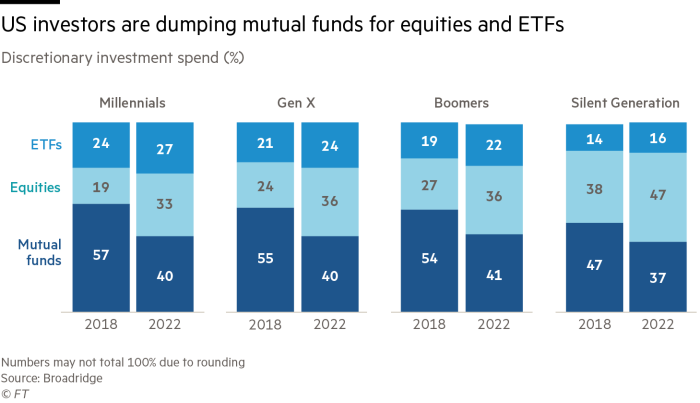Investors dump mutual funds for equities too, not only ETFs

Roula Khalaf, Editor of the FT, selects her favourite stories in this weekly newsletter.
Latest news on ETFs
Visit our ETF Hub to find out more and to explore our in-depth data and comparison tools
US investors are deserting mutual funds in their droves, but while exchange traded funds have been beneficiaries the largest swing in recent years has been to individual stocks, new research shows.
For example, 57 per cent of the discretionary investments held by millennials (born 1981-1996) was in mutual funds in 2018. By 2022 that proportion had shrunk to 40 per cent. The biggest gain was felt in direct equity holdings, which rose from 19 per cent of the average portfolio in 2018 to 33 per cent in 2022. ETFs enjoyed a smaller gain, moving from 24 per cent to 27 per cent.
A similar picture emerges for baby boomers (born 1946-1964). Mutual funds accounted for 54 per cent of their discretionary investments in 2018, but this shrank to 41 per cent in 2022. ETFs rose from 19 per cent to 22 per cent, but equities saw the biggest increase, jumping from 27 per cent in 2018 to 36 per cent in 2022.
“Right now and for the last two decades ETFs have been a primary driver of the erosion in active mutual funds. Over this same period, separately managed accounts (SMA) using individual equities have also been quite popular . . . this trend is poised to continue,” said Andrew Guillette, vice-president, global insights at Broadridge.
He noted that separate Broadridge research showed there had been a swing to both passive investment and to the ETF wrapper. Specifically, between 2018 and 2022 active mutual funds had suffered outflows of $1.8tn, while passive index mutual funds had inflows of $489mn. Over the same period passive ETFs had $1.9tn in inflows, while active ETFs had inflows of $253mn.
But he added that direct equity holdings too were benefiting from an industry trend towards more personalised portfolios. “ETFs comprise 50 per cent of assets in model portfolios and have grown at a much faster rate inside models than active mutual funds,” Guillette said. “Besides the trends towards SMAs, we are in the early days of equities-based direct indexing made possible by fintech advancements,” he added.

Bryan Armour, director of passive strategies research for North America at Morningstar, said the flood of capital outside retirement accounts from mutual funds to ETFs had been well documented.
“The bigger surprise is the increase in equities holdings by retail investors,” he said. “Investors’ penchant for stocks likely comes from two very different developments — the boom in new investor retail accounts during the Covid-19 pandemic and portfolio customisation for wealthier investors.”
He noted, however, that initial interest in custom indexing, which allows investors to tailor indices to their personal goals, had started to subside.
“As it currently stands, most investors don’t stand to gain much from this level of customisation,” he said. He noted that while this approach offered advantages in tax-loss harvesting, when investors realise losses to offset gains, the added costs could not compete with the general tax efficiency offered by ETFs.
However, Todd Rosenbluth, head of research at VettaFi, said he expected growth in both customisation and ETFs to continue.
“Investors have more access to customised individual stock portfolios and ETFs than in the past and no longer need to rely on expensive and one-size-fits-all active mutual funds,” he said. “Direct indexing and ETFs will continue to gain traction as a younger generation accumulates more wealth.”
Comments